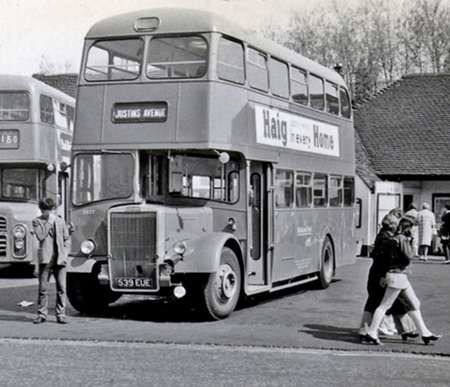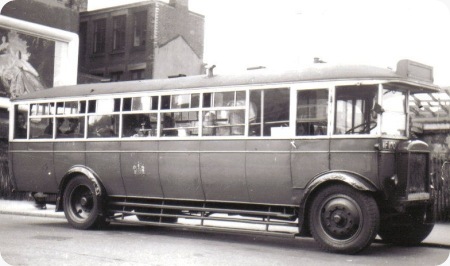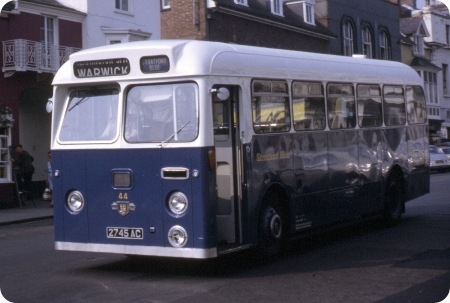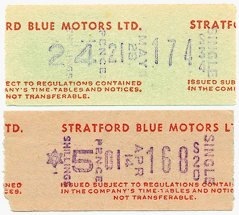Stratford Blue – Leyland Titan – 537 EUE – 25
Stratford-upon-Avon Blue Motors Ltd
1963
Leyland Titan PD3/4
Northern Counties H41/32F
My second of three Stratford Blue pictures this one is of 537 EUE, an exposed radiator Leyland Titan PD3/4 of 1963 with a Northern Counties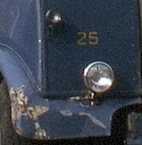 H41/32F body.
H41/32F body.
The fleet list at this site :- www.petergould.co.uk/
gives the fleet number of this bus as No.37, but the picture shows the number 25 clearly displayed. The close up also shows that the vehicle has also suffered some accident inspired remodelling of the offside front wing. This bus was withdrawn in 1971, after a short life with Stratford Blue of only 8 years.
Photograph and Copy contributed by Roger Cox
20/07/12 – 07:43
A smart, (offside mudguard excepted), and purposeful looking vehicle, so much more attractive than it would have been with a tin front. Any idea, Roger, why it was withdrawn at so young an age, and what happened to it thereafter?
Roy Burke
20/07/12 – 07:46
It is also listed as 37 in my BBF 7 Midlands something strange.
Peter
20/07/12 – 09:27
Not quite the pristine condition we’d normally expect of Stratford Blue. I’m guessing that the early withdrawal was either after another (serious) mishap or that its outline didn’t match the criteria of the parent company on take-over. After all, Midland Red are known to have kept very few of the vehicles of acquired fleets – those in the Leicester/Loughborough area being something of an exception – although I have seen views of SB vehicles in red.
Pete Davies
20/07/12 – 09:28
Agree with you, Roy. Amazing how many late (E, F, G registered) PD2s and PD3s were exposed radiator.
David Oldfield
20/07/12 – 09:30
Apparently this Bus is still in existence in Galway in Ireland. Owned by an open top tour operator (Lally’s) under the reg. no ZV 1466. It also spent some time on the Isle of Man.
David
20/07/12 – 12:24
It wasn’t ‘withdrawn’ in 1971 as such- that was the date of Midland Red’s takeover of SB.The PD3s were totally non-standard for BMMO and the whole PD3 fleet was sold to Isle of Man Road Services, the EUE batch changing hands at the start of 1972. IOMRS withdrew it in 1982. The SB renumbering took place in 1969. (Info from R. L. Telfer (2003), Stratford Blue. (Tempus).
Phil Drake
20/07/12 – 12:26
Midland Red sold as number of Stratford Blue buses to Isle of Man Road Services for further service all of which were Titans many with Willowbrook bodywork. Perhaps the most interesting disposal was a trio of Marshall Camair bodied Leyland Panthers that never turned a wheel for either Stratford Blue or Midland Red these ended up in Preston for a full life span.
Chris Hough
20/07/12 – 12:27
Interesting comment about late exposed radiator Leylands. Atkinson trucks also came like that then (any others?): it was a sort of macho quality look and possibly a sign that the fleet was engineer led!
That leads in a sort of way to BMMO buses, which seem to go too far the other way: the SOS FEDD recently featured is one of the most hideous buses I’ve ever seen (or not seen) – like an illustration in a children’s book…. to sit the driver on the fuel tank (!) and then have to put in a "peep" window over the filler…. and the proportions… words fail me. It fits with the all-red, easy maintenance but so boring look.
This leads in a sort of way to this bus! I’m not sure it is so smart. Why was it sent out without a quick splash of paint to disguise the damage- and is that diesel slop under the filler?… and then the blind doesn’t fit the destination window… What I intended to say was that the numbers on Peter Gould’s list are all over the place (the fleet, not his list) and appear almost random: here they may have thought of a number & then followed the registration instead. Soon after, it seems, they started again. As the bus would say….
Then happy I, that love and am beloved,
Where I may not remove nor be removed. Sonnet 25
Joe
20/07/12 – 12:35
Here’s a photo of it in 2003 (look just above Canada).
SEE: www.skylineaviation.co.uk/
Chris Hebbron
21/07/12 – 07:44
It is nice to see that this bus has survived, albeit in a "trepanned" state. I cannot understand why the full takeover of Stratford Blue by BMMO should have rendered the Stratford Leyland fleet suddenly "non standard". BMMO had full management responsibilities for Stratford Blue from 1935, and the fleet content was entirely a BMMO decision. If the Stratford unit could operate efficiently for so long, why should the replacement of blue and white paint by overall red suddenly rewrite the economics. BMMO in house bus manufacture had made decidedly dubious economic sense for some considerable time before the sale of the BET group to NBC in 1968, so the withdrawal of tried and trusted Leyland designs in Stratford in favour of BMMO standard types seems to have arisen from the increasing NBC fascination with the god of "standardisation" (corporate liveries and Leyland Nationals lurking just round the corner) than with operating logic.
Roger Cox
21/07/12 – 12:15
I suppose it was inevitable, if BMMO took over direct management of the concern instead of the arms-length approach, Roger
Chris Hebbron
21/07/12 – 12:16
Standardisation for it’s own sake is not always a good idea, I cant see the point of wholesale changes just for the sake of it, however, in the case of the Routemaster for example, it can work very well, but even they weren’t all bog standard and had several variants. Most Tilling group companies ‘take overs apart’ had standard fleets, where as BET companies managed very well with ‘off the peg’ vehicles, then came the curse of NBC who seemed to go out of their way to prove that Oscar Wilde was right when he said "consistency is the last refuge of the unimaginative" end result? the MK1 Leyland National, how can you spend so much time and money on R&D and get it so wrong? I suppose they must have had some good points, but off hand I cant think of any.
Ronnie Hoye
21/07/12 – 17:07
And the Leyland National body had an Italian designer, although we all recall the Mk II Morris Ital had one, too! In Gloucester, they had an all-Bristol fleet, of which the urban services were allocated RELL6L’s. But then Leyland Nationals started to arrive. Never a great Bristol lover, it was nevertheless obvious that the Nationals were inferior and a great disappointment.
Chris Hebbron
21/07/12 – 17:08
I just have to say that I enjoyed driving Leyland Nationals both for Eastern Counties, and East Kent Road Car Co. Admittedly the handling characteristics were very different, and I’ve known one driver getting caught out by forgetting to build up gearbox air pressure in neutral. The bus shot off and embedded itself into the adjacent building in Ashford by a good 6 feet injuring the female driver who was working ‘spare’ moving the buses. My favourites to drive were the Bristol RE’s and RL’s
Norman Long
21/07/12 – 17:08
Strong structure, Ronnie. certainly wasn’t the engine!
David Oldfield
22/07/12 – 08:11
As ever we seem to have strayed from the original subject, nothing new there. The PD3’s the Northern General Group had were different ‘body wise’ to these, but I always loved driving them. Harking back to Leyland Nationals, I’m lead to believe that the MK2 was a far superior beast to the MK1, but never having driven one I cant comment. On Normans point about gearbox pressure, one of Tynemouth’s MK1’s had a similar incident in North Shields, it shot forward demolishing part of a stone boundary wall that surrounds Northumberland Square and ended up in the middle of the flower beds, whereupon it sank up to its axles and had to be lifted out by a crane
Ronnie Hoye
22/07/12 – 09:01
My experience of the Nationals is just the opposite of Ronnie’s – I never drove a Mk 1 but plenty of the Mk 2 variety. As a frequent passenger, and nearby pedestrian, I found the originals to be totally unacceptable – how on Earth they were allowed to make that horrendous screaming row from the large menacingly visible fan I shall never know, and I’m sure that ANY other model, new or ancient, which threw out such enormous amounts of acrid black smoke would have rightly received an immediate prohibition notice. On the other hand, however, I really liked the Mk 2 very much indeed. Weight distribution had been greatly improved, the dreadful 500 series engine banished, and the 600 series and Gardner power units were both powerful and positively "dulcet" in tone. The finest of the 600 type which I drove was one which had been bought from South Wales by West Riding – it was one of four which South Wales had fitted when new with comfortable luxury coach seats in fawn moquette and had an "open" exhaust system. Its power and sporty but pleasant bellowing became legendary in our operating area – its number, for those familiar, was CCY 817V and I wish I could do a few miles in it right now. I apologise for deviating from the Stratford Blue topic but, as we used to say as guilty schoolboys, "It weren’t me what started it Sir."
Chris Youhill
23/07/12 – 08:05
You’ve described, Chris Y, to a ‘T’, my memories of the early Nationals. And the vehicles were so angular inside, especially the part above the top of the windows. The inside roofs soon became dirty, too, as if they were single-skinned. I think I preferred austerity bodies, on reflection! An altogether unpleasant vehicle that should never, in ‘Mk I’ form, have been put on the road.
Here’s a clip of some LN Mk I’s being cold-started – I think they might be South Riding’s vehicles. SEE: www.youtube.com/
Chris Hebbron
23/07/12 – 08:08
As ever, I’m in full accord with Chris Y.
David Oldfield
23/07/12 – 08:09
BMMO did seem to have a strange attitude towards Stratford Blue: although Stratford Blue vehicles worked on X50 (Birmingham-Stratford) for many, many years the service was never jointly licenced and Stratford Blue always worked on-hire to BMMO; and, so I’ve read, Stratford Blue vehicles were never welcome at Carlyle works. Somewhat "distant" relationships between parent companies and subsidiaries don’t seem all that uncommon: Frank Briggs managed to maintain a degree of autonomy for Standerwick from Ribble; and until the GM of Northern assumed management responsibility for Sunderland District and Gateshead the managers of the smaller companies ordered their own vehicles etc . . . but the relationship between BMMO and Stratford Blue seems particularly strange. Did it perhaps date back to the Power/Shire era? Power was reported as having looked at Stratford Blue with "admiring eyes" – did Power keep Stratford Blue separate/"independent" and so out of Shire’s engineering remit? (the two are known not to have got on), and did that translate into the appointment of a Traffic Department oriented board of Directors which persisted through the company’s subsequent history?
Stratford Blue itself had a strange approach to route numbering – when route numbers were introduced they weren’t applied to all services, and they were applied in leaps-and-bounds where they were.
I’ve got a handful of Stratford Blue Setright tickets in my collection: some on pink paper, some on white – its my understanding that Stratford-upon-Avon depot used white ticket rolls and Kineton depot used pink rolls.
And those Leyland Panthers that never turned a wheel . . . were they really a sound choice for a such a small company? – I can’t see that the traffic on Stratford-upon-Avon local services really justified dual-door buses. And weren’t those centre doors the cause of their "delayed" entry into service? I think that they had outwardly-sliding centre doors (now common, but then rare [Ribble specified them on some of its RELLs . . . anybody know of any others?]), and it was problems with these that caused the Deputy Manager to reject delivery from Marshalls as he didn’t feel able to accept delivery in the absence of the Manager (who was absent on leave) – and then the company was wrapped-up before they could enter service. They were subsequently painted into "Midland Red" livery but were "blacked" by BMMO staff (and then spent the rest of their time with BMMO parked out-of-use at Digbeth Depot’s Adderley Street over-spill parking area): which raises two questions – why did BMMO apparently intend on keeping these non-standard vehicles when the rest of the Stratford Blue fleet (including some quite new Atlanteans) was disposed of PDQ (although, given, they did repaint some Titans that didn’t stay long)? and why did BMMO crews refuse to work with the Panthers? (was it because they were dual door? – but then BMMO had its own dual-door DD11/12 Fleetlines).
Philip Rushworth
08/05/13 – 08:32
It was nothing to do with being ‘blacked’ by Midland Red drivers. The Panthers were parked up at Adderley Street in Birmingham to await disposal after the West Midlands Traffic Commissioners refused approval of the plug in doors on safety grounds. Other area commissioners did not have a problem with them. As a matter of interest the dual door Fleetlines were soon operated as single door buses with the centre doors fixed shut. This was due to even moderate nearside crosswinds opening the centre doors and disengaging the gearbox whilst bus was in in motion. The doors were controlled through the semi automatic gear stick and set up so that the bus could not be driven with the centre doors open.
Mike Holloway
09/05/13 – 07:41
If anyone misses the noise from Mk1 Nationals come to Leeds and follow one of the ftrs they are noisy!
Chris Hough
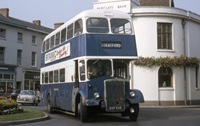 Vehicle reminder shot for this posting
Vehicle reminder shot for this posting
18/05/17 – 14:53
Sister bus 539 EUE seen at the Red Lion bus station, Stratford. The young gentleman seems to have his attention elsewhere!
Tony Martin
Quick links to the - Comments Page - Contact Page - Home Page

